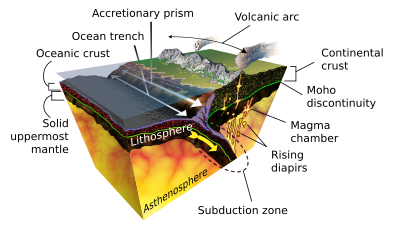
A diapir ( /ˈdaɪ.əpɪər/; [1] [2] [3] from French diapir [djapiʁ], from Ancient Greek διαπειραίνω (diapeiraínō) 'to pierce through') is a type of intrusion in which a more mobile and ductily deformable material is forced into brittle overlying rocks. Depending on the tectonic environment, diapirs can range from idealized mushroom-shaped Rayleigh–Taylor instability structures in regions with low tectonic stress such as in the Gulf of Mexico to narrow dikes of material that move along tectonically induced fractures in surrounding rock.
The term was introduced by Romanian geologist Ludovic Mrazek, who was the first to understand the principle of salt tectonics and plasticity. The term diapir may be applied to igneous intrusions, but it is more commonly applied to non-igneous, relatively cold materials, such as salt domes and mud diapirs. If a salt diapir reaches the surface, it can flow because salt becomes ductile with a small amount of moisture, forming a salt glacier. [4]
Occurrence

Differential loading causes salt deposits covered by overburden ( sediment) to rise upward toward the surface and pierce the overburden, forming diapirs (including salt domes), pillars, sheets, or other geological structures.
In addition to Earth-based observations, diapirism is thought to occur on Neptune's moon Triton, Jupiter's moon Europa, Saturn's moon Enceladus, and Uranus's moon Miranda. [5]
Formation
Diapirs commonly intrude buoyantly upward along fractures or zones of structural weakness through denser overlying rocks.[ citation needed] This process is known as diapirism. The resulting structures are also referred to as piercement structures.[ citation needed] In the process, segments of the existing strata can be disconnected and pushed upwards. While moving higher, they retain many of their original properties, e.g. pressure; their pressure can be significantly different from the pressure of the shallower strata they get pushed into.[ clarification needed] Such overpressured "floaters" pose a significant risk when trying to drill through them.[ clarification needed] There is an analogy to a Galilean thermometer. [6]
Rock types such as evaporitic salt deposits, and gas charged muds are potential sources of diapirs. Diapirs also form in the Earth's mantle when a sufficient mass of hot, less dense magma assembles. Diapirism in the mantle is thought to be associated with the development of large igneous provinces and some mantle plumes.
Explosive, hot volatile rich magma or volcanic eruptions are referred to generally as diatremes. Diatremes are not usually associated with diapirs, as they are small-volume magmas which ascend by volatile plumes, not by density contrast with the surrounding mantle.
Economic importance

Diapirs or piercement structures are structures resulting from the penetration of overlaying material. By pushing upward and piercing overlying rock layers, diapirs can form anticlines (arch-like shape folds), salt domes (mushroom/ dome-shaped diapirs), and other structures capable of trapping hydrocarbons such as petroleum and natural gas. Igneous intrusions themselves are typically too hot to allow the preservation of preexisting hydrocarbons. [7]
Occurrences

There are many salt domes and salt glaciers in the Zagros mountains, formed by the collision of two tectonic plates, the Eurasian Plate and the Arabian Plate. There are underwater salt domes in the Gulf of Mexico. [8] [9]


See also
- Geyser – Natural explosive eruption of hot water
- Methods of pluton emplacement – The ways magma is accommodated in a host rock where the final result is a pluton
- Mud volcano – Landform created by the eruption of mud or slurries, water and gases
References
- ^ "diapir". The American Heritage Dictionary of the English Language (5th ed.). HarperCollins.
- ^ "diapir". Dictionary.com Unabridged (Online). n.d.
- ^ "diapir". The American Heritage Dictionary of the English Language (4th ed.). Houghton Mifflin. 2000. Archived from the original on 2006-12-08. Retrieved 2006-12-20.
- ^ Talbot, Christopher J.; Jackson, Martin P. A. (1987). "Salt Tectonics". Scientific American. 257 (2): 70–79. Bibcode: 1987SciAm.257b..70T. doi: 10.1038/scientificamerican0887-70. ISSN 0036-8733. JSTOR 24979445.
- ^ Cassini Imaging Central Laboratory for Operations, Enceladus Rev 80 Flyby: Aug 11 '08 Archived 2016-03-03 at the Wayback Machine. Retrieved 2008-08-15.
- ^ Don L. Anderson (2007). "The eclogite engine: Chemical geodynamics as a Galileo thermometer". In Gillian R. Foulger, Donna M. Jurdy (ed.). Plates, plumes, and planetary processes; Volume 430 of Special Papers. American Geological Society. ISBN 978-0-8137-2430-0.
- ^ Schlumberger Oilfield Glossary, on-line at [1] Archived 2009-03-05 at the Wayback Machine. Retrieved 2008-08-15.
- ^ "NOAA Ocean Explorer: Gulf of Mexico Deep Sea Habitats: Sept 23 Log". oceanexplorer.noaa.gov. Retrieved 2023-07-26.
- ^ US Department of Commerce, National Oceanic and Atmospheric Administration. "Geologic Overview of the Gulf of Mexico: Gulf of Mexico 2018: NOAA Ship Okeanos Explorer: NOAA Office of Ocean Exploration and Research". oceanexplorer.noaa.gov. Retrieved 2023-07-26.
- ^ Beckman, Jeffery D., and Alex K. Williamson. Salt-dome locations in the Gulf Coastal Plain, south-central United States. Vol. 90. No. 4060. US Geological Survey, 1990.